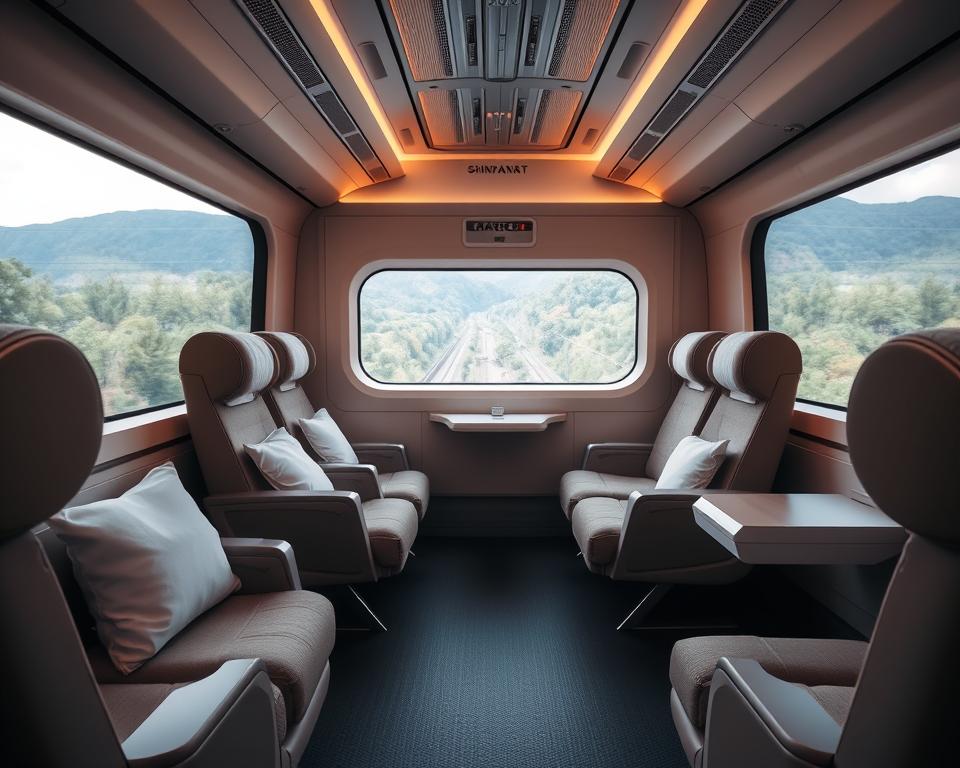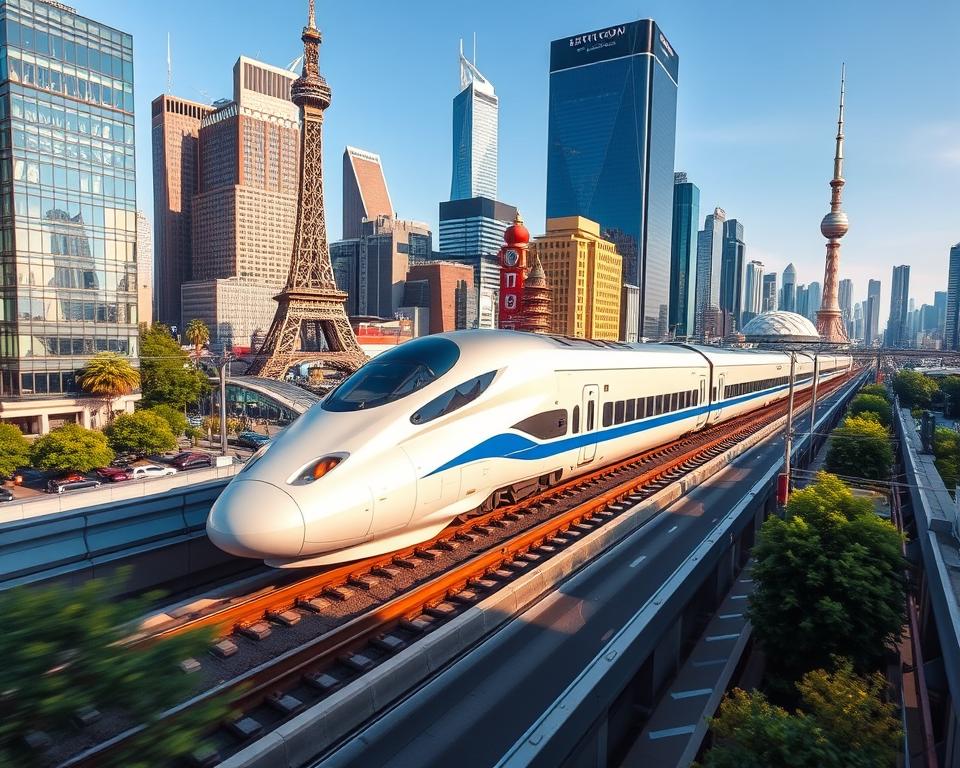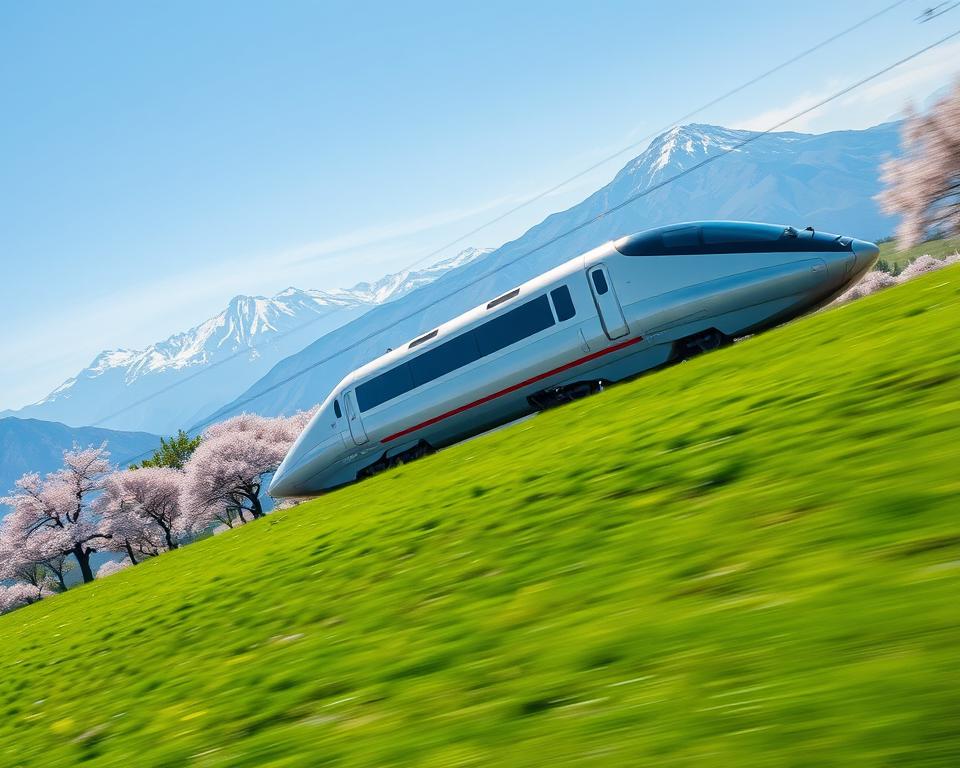The Shinkansen, Japan’s famous high-speed rail, has amazed the world. It’s known for its top-notch performance, advanced engineering, and big impact on Japan’s economy and travel. It’s seen as a top rail network globally, showing Japan’s tech skill and efficient travel.
This article tells the amazing story of the Shinkansen. We’ll look at its history, latest tech, safety, and big effect on Japan and the world. From starting as a dream project to being a world leader in high-speed rail, the Shinkansen’s story is one of creativity, efficiency, and lasting greatness.
Read interesting things at : info-kirara
Key Takeaways
- The Shinkansen, Japan’s high-speed rail system, is renowned for its exceptional performance, innovative engineering, and transformative impact on the nation’s economy and transportation landscape.
- The Shinkansen has earned a reputation as one of the most advanced and reliable rail networks in the world, serving as a symbol of technological prowess and efficient mobility.
- This article explores the Shinkansen’s history, cutting-edge technology, unparalleled safety standards, and the profound influence it has had on Japan’s urban development and global transportation trends.
- The Shinkansen’s journey is one of innovation, efficiency, and enduring excellence, making it a global benchmark for high-speed rail.
- The Shinkansen’s state-of-the-art technology, seamless integration with Japan’s transportation network, and commitment to safety and sustainability have enabled it to become a model for high-speed rail systems worldwide.
The Shinkansen: A Marvel of Modern Rail Transportation
The Shinkansen, Japan’s iconic high-speed rail network, is a true marvel. It boasts unparalleled speed, efficiency, and technological innovation. This has revolutionized transportation in Japan and sets a global benchmark for the railway industry.
Unraveling the Shinkansen’s Innovative Engineering
The Shinkansen’s success comes from its groundbreaking engineering. It’s designed to minimize air resistance and maximize stability. This allows it to reach speeds of up to 200 mph (320 km/h), making it one of the fastest passenger trains globally.
The Shinkansen’s sleek and aerodynamic design, along with advanced propulsion systems and sophisticated signaling technologies, has pushed rail engineering boundaries. It has set new standards for the industry.
Powering Japan’s Economic Growth through Efficient Mobility
The Shinkansen’s impact on Japan’s economy is significant. It connects major cities and hubs, revolutionizing business and commuter travel. This reduces travel times and boosts productivity.
This efficient mobility has fueled economic growth across various sectors. From manufacturing and logistics to tourism and urban development, the Shinkansen has played a key role. It has been a driver of Japan’s prosperity and global competitiveness.
“The Shinkansen is not just a train, it’s a symbol of Japan’s technological prowess and a testament to the power of innovation in transportation.”
The Shinkansen’s remarkable engineering and its transformative impact on Japan’s economy make it a true marvel. As the world seeks sustainable and efficient mobility solutions, the Shinkansen’s legacy is a shining example. It shows what can be achieved through rail infrastructure development and innovation.
Exploring the History of the Shinkansen
The Shinkansen, Japan’s famous high-speed rail, started in the mid-20th century. It was needed to update old rail lines and meet growing passenger needs. The idea of a fast, modern train system began to form.
In the 1930s, Japanese engineers started working on train designs inspired by planes. This early work helped create the Shinkansen trains we know today. They set new standards for rail travel around the world.
By the 1940s, Japan’s economy and population were growing fast. The old rail network couldn’t keep up. The government then planned to update the rail system, leading to the Shinkansen project.
In 1964, the Tōkaidō Shinkansen line opened just in time for the Tokyo Olympics. It was a major breakthrough, reaching speeds of up to 210 km/h. This made the Shinkansen famous worldwide.
Since then, the Shinkansen has grown and improved, making Japan a leader in high-speed rail. Today, it connects many cities across Japan, changing how people travel.
The Shinkansen’s success shows Japan’s creativity and dedication to better transportation. It’s a model for sustainable mobility in the future. The Shinkansen proves how good planning and engineering can change rail travel.
The Shinkansen’s State-of-the-Art Technology
The Shinkansen, Japan’s famous high-speed rail, is known for its advanced technology and engineering. It stands out for its focus on innovation and efficiency. This has changed the way we travel.
Unlocking the Secrets of High-Speed Rail Efficiency
The Shinkansen’s speed and reliability come from its advanced systems. It has powerful electric motors and a sleek design. These features help it travel fast and use less energy.
Its signaling system is also top-notch. It uses real-time monitoring and automatic control. This ensures trains run smoothly and on time.
Seamless Integration: Shinkansen’s Role in Japan’s Transportation Network
The Shinkansen is more than just fast trains. It’s a key part of Japan’s transportation system. It connects cities and airports, making travel easier.
It works well with other transport options like local trains and buses. This makes traveling in Japan more efficient. It reduces the need for long transfers.
“The Shinkansen’s state-of-the-art technology is the driving force behind its unparalleled rail efficiency and integration into Japan’s broader transportation network.”
Unprecedented Safety and Reliability
The Shinkansen, Japan’s famous high-speed rail, is known for its speed and safety. It has strict safety standards and careful operations. This makes it one of the safest high-speed rails globally.
Stringent Safety Standards: A Hallmark of the Shinkansen
The Shinkansen focuses a lot on safety. Its trains are built with the latest technology and safety features. This ensures the safety and reliability of passengers.
The rail safety standards of the Shinkansen are very high. It has regular checks and updates to keep the system safe. This dedication to safety has made the Shinkansen a reliable choice for millions.
“The Shinkansen’s safety record is unparalleled, with no passenger fatalities in its entire history of operation. This is a testament to the unwavering commitment to safety that is at the heart of the Shinkansen system.”
As the Shinkansen grows, its focus on safety will stay strong. This ensures a safe and smooth journey for all passengers.
Shinkansen: An Eco-Friendly Transportation Solution
The world faces a big challenge with climate change. Japan’s high-speed rail, the Shinkansen, shows us a way forward. It’s a model of green transport, thanks to its high efficiency and new tech.
The Shinkansen is a leader in reducing harm to the environment. Its shinkansen sustainability is key. It has much lower high-speed rail emissions than flying or driving. This is thanks to careful design and a strong focus on being green.
- Regenerative Braking: The Shinkansen’s advanced braking system turns energy back into electricity. This cuts down on energy use and emissions.
- Lightweight Design: The Shinkansen is made with light materials. This means it uses less energy and produces less carbon.
- Streamlined Aerodynamics: Its sleek design cuts down on air resistance. This makes it more energy-efficient and lowers high-speed rail emissions.
“The Shinkansen’s unwavering commitment to sustainability is a testament to Japan’s vision for a greener transportation future.”
The Shinkansen goes beyond just tech. It’s also dedicated to caring for the environment. It uses energy-saving maintenance and renewable energy. This shows us what’s possible when we combine innovation, efficiency, and caring for the planet.
The Passenger Experience: Comfort and Luxury Aboard the Shinkansen
Getting on the Shinkansen, Japan’s famous high-speed rail, is an adventure. From the start, passengers enjoy unmatched comfort and luxury. Every detail shows the Shinkansen’s dedication to making travel special.
The Shinkansen’s seats are spacious and stylish. They’re designed for comfort, with lots of legroom and recline. The climate control keeps the air perfect, making the ride smooth.
| Shinkansen Passenger Amenities | Standard | Green Car (First Class) |
|---|---|---|
| Seat Pitch | 100 cm | 115 cm |
| Seat Recline | 4 inches | 6 inches |
| Power Outlets | Yes | Yes |
| Complimentary Beverages | No | Yes |
| Service Attendants | Yes | Yes |
The Green Car (first-class) offers a luxurious ride. It has more space, deeper seats, and free drinks. It’s as good as business class on a plane.
“Traveling on the Shinkansen is a seamless and enjoyable experience. The attention to detail, from the comfortable seating to the impeccable cleanliness, is truly impressive.”
The Shinkansen meets today’s traveler’s needs. There are power outlets for charging devices. The trains are safe and reliable, making the ride relaxing.

Whether for work or fun, the Shinkansen offers top-notch comfort and luxury. It shows Japan’s focus on detail and quality in rail travel.
Shinkansen’s Impact on Japan’s Urban Development and Tourism
The Shinkansen, Japan’s high-speed rail network, has greatly changed the country. It has improved urban planning and tourism. This advanced transportation system has reshaped cities and travel across Japan.
Transforming Cities: The Shinkansen’s Influence on Urban Planning
Shinkansen stations have become key in city planning. They have helped cities build better places to live and work. Shinkansen urban development has made communities more sustainable and connected.
The Shinkansen has also helped rural and suburban areas. It connects them to big cities, boosting tourism. Now, people can easily see Japan’s beauty and culture.
| Key Impact of Shinkansen on Urban Development | Benefit to Cities and Residents |
|---|---|
| Integrated transportation hubs | Improved connectivity and accessibility |
| Revitalization of rural and suburban areas | Increased economic opportunities and tourism |
| Sustainable urban planning and design | Livable, environmentally-friendly communities |
Japan keeps improving its Shinkansen network. This will keep changing cities and towns. It will drive growth, connect people, and help the environment.
The Future of High-Speed Rail: Innovations on the Horizon
The world is changing fast, and high-speed rail is leading the way. Japan’s Shinkansen is at the heart of this change. It shows us what’s next in rail travel, with new tech that will change how we travel.
Cutting-Edge Advancements in Shinkansen Technology
Shinkansen engineers are always looking to do more. They’re working on trains that can go super fast, thanks to new tech. They’re also using smart AI to make travel smoother and safer.
- Maglev technology: The next Shinkansen trains will use magnetic levitation. This lets them go over 600 km/h (375 mph), cutting travel times.
- Intelligent control systems: AI and machine learning will make the Shinkansen run better. It will use less energy, be safer, and offer a better ride for passengers.
- Sustainable energy sources: Scientists are looking into using solar power and regenerative braking. This will make the Shinkansen even greener.
These steps forward in high-speed rail future, shinkansen technology advancements, and rail transportation innovation are just the start. The Shinkansen is always finding new ways to improve high-speed rail.
“The future of the Shinkansen is a testament to Japan’s unwavering commitment to innovation and excellence in rail transportation.”
The Shinkansen is getting better all the time. It will change how we travel and inspire others to innovate in rail transportation innovation.
Shinkansen’s Global Influence and Export Opportunities
The Shinkansen high-speed rail system from Japan has made a big splash worldwide. Its engineering and operation are top-notch. This has made the Shinkansen a sought-after export, with many countries wanting to use its Japanese rail technology.
The Shinkansen’s global influence has been huge. It has inspired high-speed rail projects in many places, from Europe to Asia. Countries looking to update their transport systems have sought Japan’s help. They see the high-speed rail export as a game-changer.
In Taiwan, the Shinkansen technology has changed how people travel between cities. This partnership has boosted Japan-Taiwan relations. It also shows how the Shinkansen can work well in different places.
| Country | Shinkansen Export Project | Status |
|---|---|---|
| Taiwan | Taiwan High-Speed Rail | Operational since 2007 |
| United Kingdom | HS2 High-Speed Rail | Under construction |
| India | Mumbai-Ahmedabad High-Speed Rail | Under construction |
As more people want efficient and green transport, the Shinkansen’s global influence will likely grow. It’s known for its safety, energy use, and success. The Shinkansen is a top example of Japanese rail technology that impresses everyone.

“The Shinkansen is a marvel of engineering, and its global influence is a testament to the innovation and craftsmanship of the Japanese rail industry.”
Challenges and Controversies Surrounding the Shinkansen
The Shinkansen, Japan’s famous high-speed rail, has faced many challenges and controversies. It has evolved over time, dealing with political, economic, and environmental debates. These debates have shaped its development and operation.
One big shinkansen challenge is the huge financial investment needed. Building new Shinkansen lines has met opposition from local communities and environmental groups. They worry about the impact on the landscape and wildlife. Also, the ongoing costs of the Shinkansen have sparked high-speed rail controversies. People discuss ticket prices, government subsidies, and economic benefits.
Another issue is integrating the Shinkansen with Japan’s transportation network. Rail infrastructure issues like connecting the Shinkansen to local transport have been debated. There are also concerns about replacing traditional rail services.
| Challenge | Description |
|---|---|
| Financial Investment | The significant costs associated with constructing and maintaining Shinkansen infrastructure have faced opposition from local communities and environmental groups. |
| Integration with Existing Transportation | Integrating the Shinkansen into Japan’s broader transportation network, including connections to local public transportation, has been a point of discussion and debate. |
| Environmental Impact | The environmental impact of Shinkansen construction and operation, particularly on the surrounding landscape and wildlife, has been a source of controversy. |
Despite these challenges, the Shinkansen is crucial for Japan’s transport. It keeps evolving to meet the country’s needs. Moving forward, finding a balanced solution is key. This will ensure the Shinkansen’s success and positive impact on Japan’s economy and society.
The Economic Impact of the Shinkansen
The Shinkansen, Japan’s famous high-speed rail, has greatly impacted the country’s economy. It has changed how people and goods move, boosting growth and productivity. This advanced rail system is crucial for Japan’s economic success.
Analyzing the Costs and Benefits of High-Speed Rail Infrastructure
Building and growing the Shinkansen costs a lot, but it’s worth it. Research shows it brings more benefits than costs. It helps businesses grow, creates jobs, and boosts the economy.
The Shinkansen makes businesses more efficient. It cuts travel times, letting companies reach more markets and work better. This leads to more economic activity and a stronger business scene.
| Metric | Impact |
|---|---|
| Travel Time Reduction | Increased productivity and efficiency for businesses |
| Improved Connectivity | Expanded market access and new business opportunities |
| Job Creation | Thousands of jobs generated during construction and operation |
| Economic Growth | Estimated GDP increase of 3-4% in regions with Shinkansen stations |
The Shinkansen’s effects go beyond just moving people and goods. It has shaped cities and tourism. It connects cities, boosting regional economies and city life.
Japan keeps investing in the Shinkansen, expecting more economic gains. This high-speed rail will keep driving Japan’s economic growth.
Conclusion: The Shinkansen’s Enduring Legacy
The Shinkansen, Japan’s high-speed rail network, has made a lasting impact on transportation. It shows Japan’s skill in technology and creativity. Its legacy goes beyond the rails, influencing Japan’s cities, economy, and global image.
The Shinkansen focuses on safety, efficiency, and being green. It has raised the bar for high-speed rail around the world. It has changed how people and goods travel in Japan, boosting the economy and making Japan a leader in building infrastructure.
Its stations have become centers for new communities and tourism. The Shinkansen’s tech and design inspire new high-speed rail projects worldwide. It stands as a symbol of engineering greatness and economic growth, shaping the future of travel.
